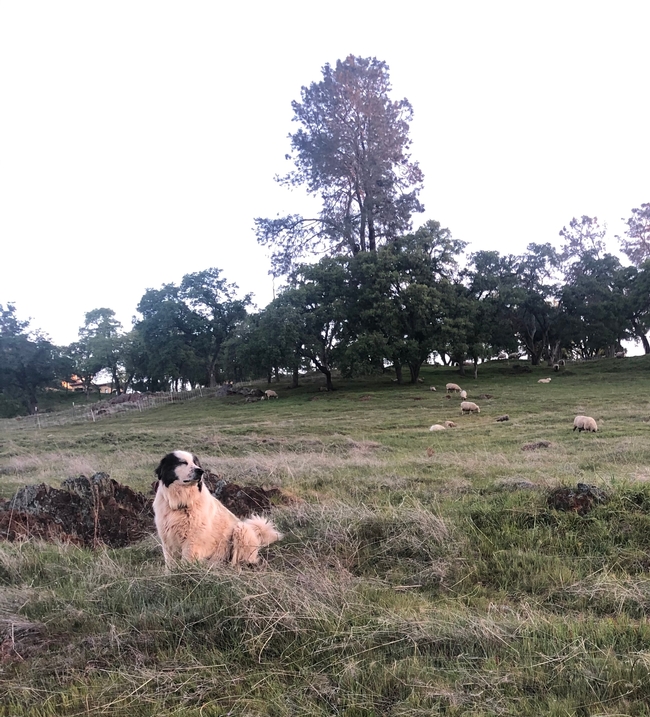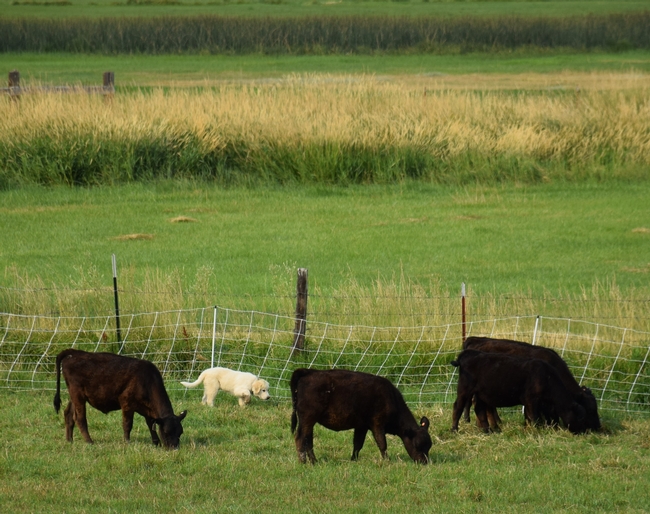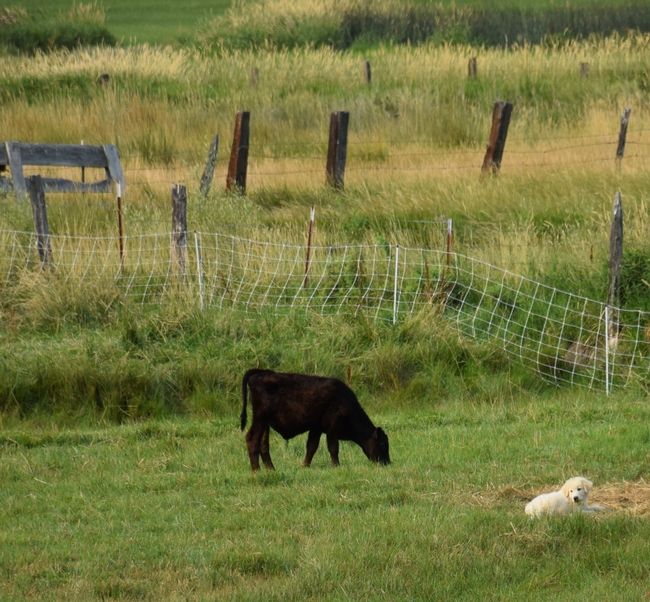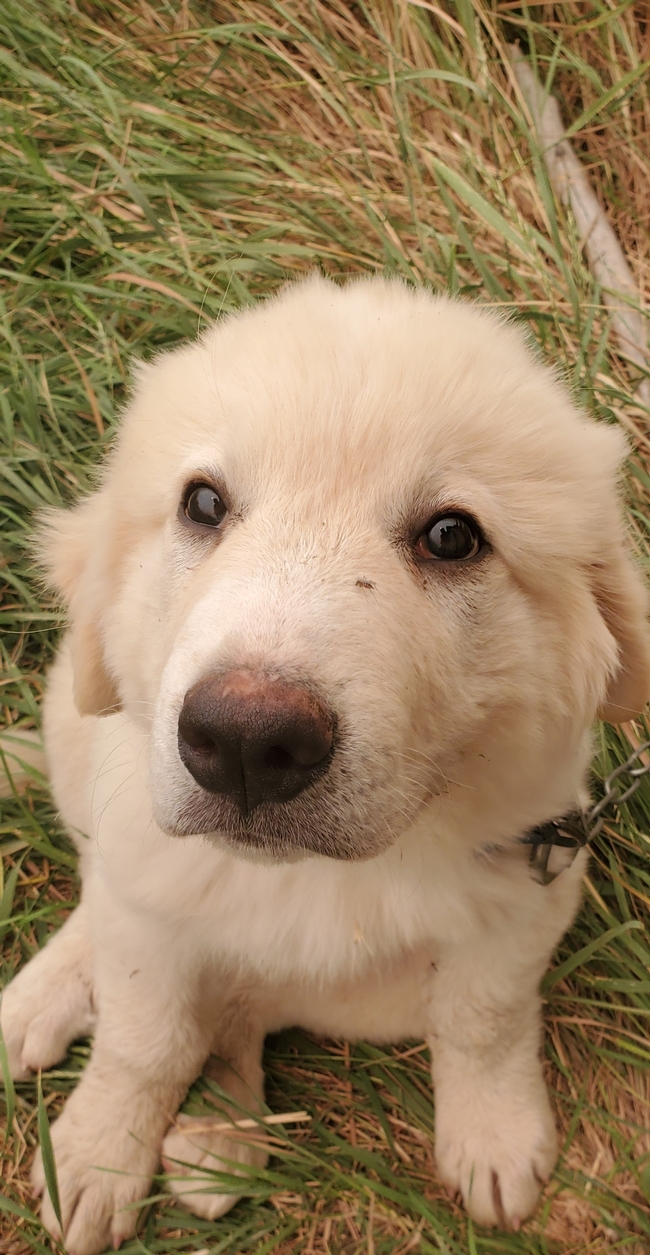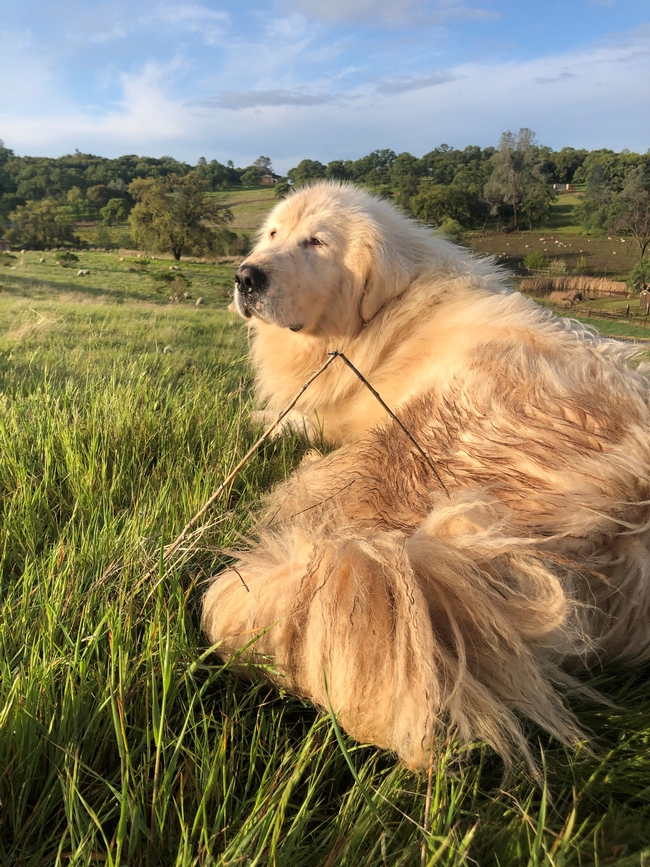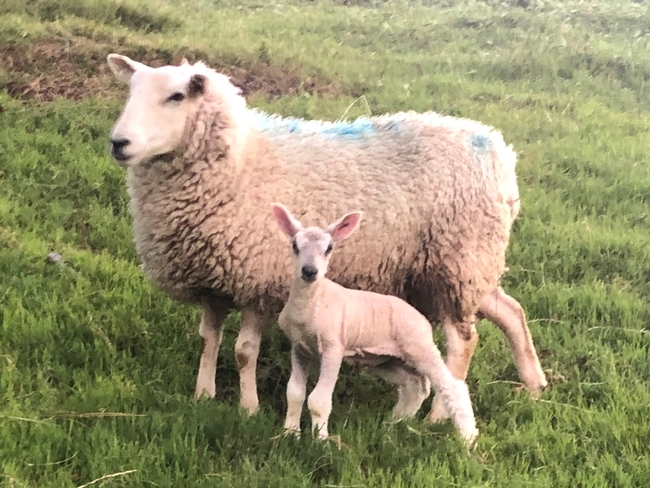- Author: Dan Macon
- Author: Laura Snell
- Author: Rachael Stucke
Our ongoing journal about our efforts to bond a livestock guardian dog pup with cattle. Funded by the Rustici Rangeland and Cattle Endowment.
After spending about a week with a handful of rams in Auburn, we scheduled an afternoon to set up a bonding pen at Likely Land and Livestock in Modoc County last week. The pup (named Sam by the ranch!), rode in a crate in the back seat of the pickup. He was unhappy about the crate for about the first 4 miles; after that he slept for most of the 5-hour drive! We stopped twice to stretch our legs and get a drink – which meant he got his first lessons on a leash. He did great! And once we arrived, we tethered him to a fence post while we set up our equipment – lesson number 2 was also a success!
The ranch provided seven small calves for the bonding process. The calves are in a small irrigated pasture grazing and being hand-fed grain. Size-wise, they aren't much larger than the rams that Sam had been with. To make sure Sam stays with the calves, we cut the pasture in half using electro-net fencing (including along the perimeter fence) – the initial bonding pen is about one acre in size. We also built a small 8' x 8' escape pen from wire panels where he can go if he feels threatened by the calves. Upon completing the fencing and pen, we fed Sam and made sure that he saw the calves (and vice versa). And then we left them for the night!
When Rachael Stucke, a UCCE intern, showed up the next morning to feed him, Sam was sleeping in the middle of the calves – a great sign! We still have a long road ahead, but the first steps have all been positive!
During this initial phase, we'll will observe Sam on a regular basis from a distance for evidence of prey drive, submissive behavior towards livestock, and a calm temperament. While some things like chasing stock can be corrected if dealt with sternly and immediately, other things like dominant behavior towards livestock is more difficult to change in a pup. Pups tend to be easily excited when humans are with them, but when observed from a distance he should slowly approach livestock and remain calm unless he is alerted to a predator or unknown animal at their location. The livestock should remain calm, as well.
Specifically, we'll watch for evidence of the following behaviors:
- Prey Drive: this includes stalking behavior, as well as chasing or biting the livestock. If any of us do observe this behavior, we'll correct it by saying “NO” in a gruff voice. As Sam matures, he should not exhibit these behaviors at all.
- Submissive Behavior: Sam will likely be curious but somewhat cautious at first around the cattle. Appropriate submissive behaviors include avoiding eye contact with the cattle, walking (rather than running) when approaching cattle, dropping to the ground or rolling over when near cattle, lowering the head and tail, licking at the mouths of the cattle, and choosing to sleep next to the cattle.
- Calm Temperament: We think we've selected a pup with a calm temperament, but we will to be sure he's not overly aggressive, fearful, shy, or clingy; he should also not be overly excited to see people. We'll watch for him to walk off by himself after greeting us or being fed.
If the cattle are being too rough with him, we will try different cattle. Similarly, if Sam starts being too rough, older cattle may help teach the pup to be submissive and respectful.
After our initial set-up day, Rachael observed that Sam seems to want to be with the calves when there are not people around. He will follow people in his pen, and he will whine briefly when people leave (which are normal behaviors). She also noted that the calves seem to be comfortable around Sam. She did observe some play behavior, which provoked the calves to lunge gently. Sam responded by trotting way from the calves or showing submissive behavior.
Going forward, the ranch will do most of the observation and virtually all of the early care and training. Several times a week, someone will spend 5-10 minutes socializing Sam to humans. They'll rub their hands all over the dog, especially his feet, and place their fingers inside his mouth to check tooth development. They'll also check ears for ticks and infections and brush him if possible.
After the first month, they'll begin teaching basic commands. Sam should know his name and come when he's called (or at least not run off!). He should also know the meaning of “No!” Critically, we'll always make sure any and all positive reinforcement (praise, etc.) is done in an area with livestock!
They'll also continue the leash and tether training I started on our trip to Likely. Leash training should start out slowly (maybe 2-3 minutes at a time) until Sam will walk without pulling away from his handler. Tether training is important in case he ever gets caught in a snare. Tethering is also useful when working cattle or doing other activities where the dog might get in the way.
Teaching Sam to ride in the pick-up truck and stock trailer is also important. Early on, he should learn to ride in the cab of the truck or in a crate. As he grows, he can be taught to ride in the back of a pickup and in a stock trailer.
As with training or bonding with any animal, this won't be a linear process. Some lessons will probably need to be learned several times; other lessons will be solid the first time through. But we're off to a promising start!
- Author: Dan Macon
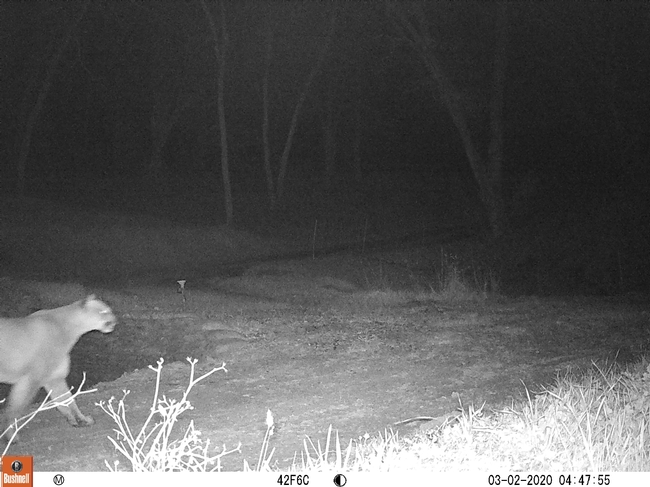
As I've written numerous times, research into the efficacy of livestock protection tools, including livestock guardian dogs, is difficult (if not impossible). The traditional model for scientific inquiry - that of comparing a treatment to a control - is extremely challenging when it comes to livestock protection tools. Fundamentally, nobody wants to be part of the control group (that is, nobody wants to leave a group of livestock unprotected to see if the treatment works!). Further challenges arise when we begin thinking about other variables - questions like the specific environment, the predators in that environment, the dietary preferences of those predators, the surrounding land uses, and so on.
Yet these challenges don't mean that we shouldn't try to shed light on questions about where specific livestock protection tools may work, or where they may fail. I like the idea of doing case studies - real world examples of the success or failure of these tools. In my mind, a useful case study would objectively describe as many of the site- and operation-specific details as possible. Case studies could take into account that many real-world management systems employ multiple tools. And case studies could be important whether or not a particular approach successfully prevented predator losses - sometimes we learn more from our failures than from our successes. The following account, then, is my first attempt at writing one of these case studies.
The Context
Flying Mule Sheep Company grazes approximately 100 head of sheep on foothill annual rangeland west of Auburn, California, from mid-December through early April. The flock is comprised of bred ewes (approximately 80 head) and replacement yearling ewes (approximately 20 head). The grazed landscape is a large-lot subdivision (20-40 acre lots). Individual parcels are connected via paved and unpaved private roads and Nevada Irrigation District canals. Many residences have domestic dogs; some have horses and donkeys. Vegetation in the grazed landscape includes open grasslands, blue/live oak savanna, blue/live oak woodland, and riparian vegetation. Surrounding land uses include grazing land (cattle, sheep, and goats) and a large regional park (mostly wildland).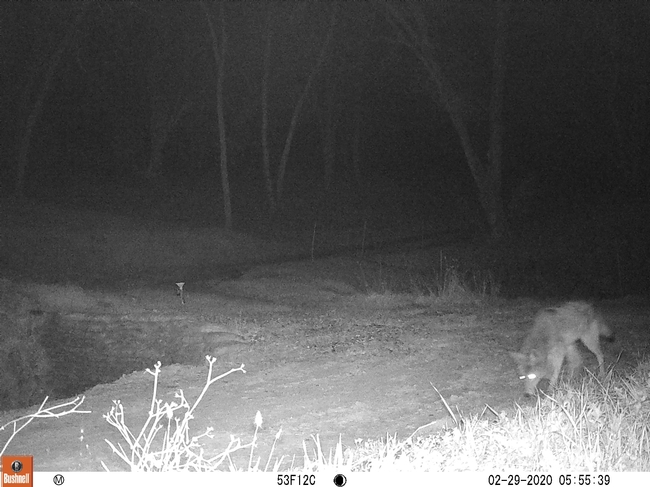
Twelve game cameras were placed throughout the grazed landscape in late December. Cameras were placed adjacent to game trails, roads, and canals to help determine the species of wildlife present and the frequency of camera "capture" in relationship to the proximity of livestock guardian dogs and sheep. In order of prevalence in game cameras from late December through early April, I noted coyotes, foxes, bobcats, and a single mountain lion (in the evening on March 1, 2020). Other wildlife caught on camera included deer, raccoons, skunks, jackrabbits, and turkeys.
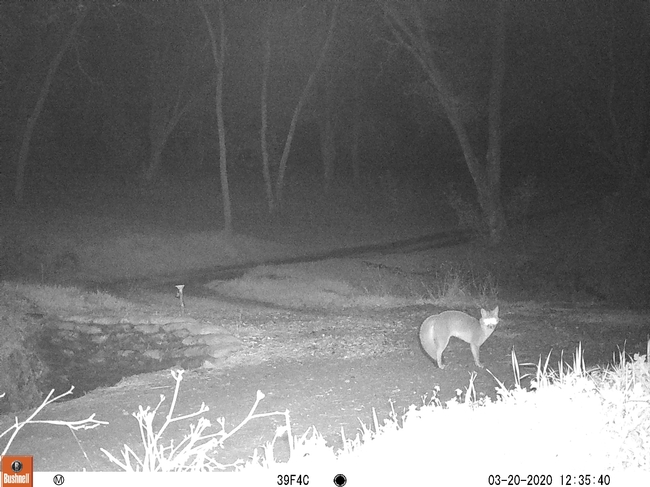
Results
During the graze period (December 15, 2019 through April 6, 2020), we had no predator losses. In early February, I found a buck that was likely killed by a mountain lion. On the night that we documented the mountain lion in a game camera (March 1), the flock was in a 13-acre paddock, the boundary of which was about 30 yards away from the camera location. On that date, there were 47 lambs with the ewes (between the ages of 1 day and 11 days). The sheep had been moved into this paddock on the morning of March 1. We lost three lambs during the time the sheep were in that paddock due to starvation or mis-mothering.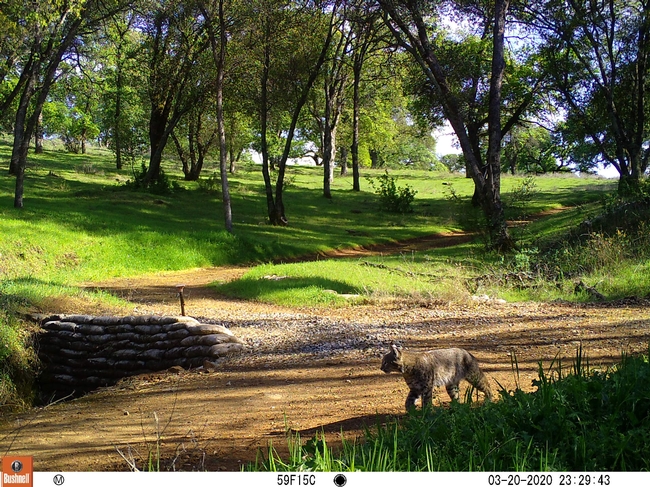
Conclusions
From a purely scientific standpoint, I cannot say that the dogs and electric fence prevented predation. While the cameras clearly demonstrated that we had predators in the vicinity of the sheep, I don't know that these specific predators would have killed sheep (rather than wildlife prey) if they'd had the opportunity. I don't know if these predators took livestock from unprotected herds/flocks during the same time period. That said, I can conclude that I feel much safer having dogs with the sheep in this landscape! I can also conclude that the mountain lion I caught in my camera has probably seem me more than I've seen it!
